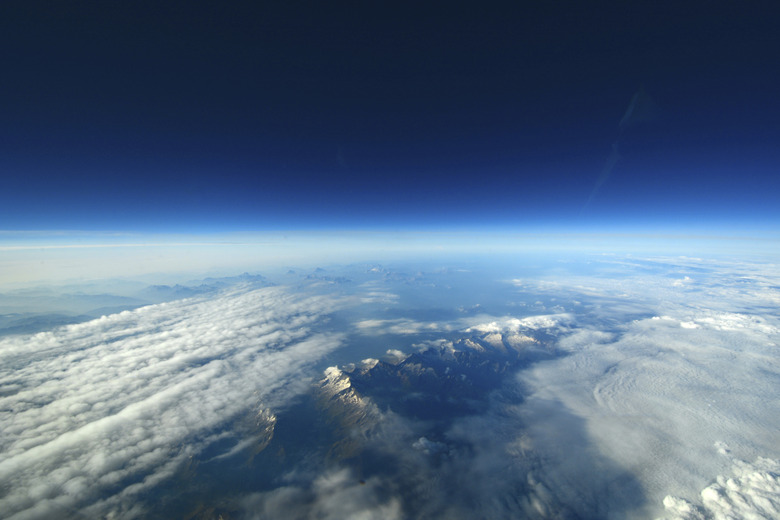How Does The Earth's Atmosphere Protect Living Organisms?
Composition and Layers of the Atmosphere
The atmosphere surrounding the Earth is made up of many gases, the most prevalent of which are nitrogen and oxygen. It also contains water vapor, dust and ozone. In the lowest layer of the atmosphere — the troposphere — the higher up you go, the lower the temperature. Above the troposphere is the stratosphere, the area where jet planes often fly. The temperature increases as you move up through this layer because of ozone, which absorbs solar radiation. Above the stratosphere is the mesosphere and the thermosphere, where it is hot and the air is thin. Finally, there is the exosphere, where many satellites orbit.
Ozone Layer
Ozone Layer
Ozone is concentrated mainly in the stratosphere, where it absorbs solar radiation, protecting Earth's living organisms from the ultraviolet light from the sun. UV radiation is harmful to DNA; without the atmosphere's ozone, living organisms could not exist and thrive as they do now. UV light causes cancer and cataracts, and it damages DNA. In recent years, the ozone layer has thinned as a a result of man-made chemicals.
Greenhouse Effect
Greenhouse Effect
The greenhouse effect refers to the ability of some components of the atmosphere — primarily carbon dioxide — to absorb and trap heat. While too much heat is a problem — consequences being a change in weather and climate, and a rise in sea levels — the greenhouse effect is a necessary protector of life on Earth. It lets the atmosphere function like a blanket, allowing for temperatures hospitable to the planet's life. People exhale carbon dioxide and release it into the atmosphere when burning fossil fuels and plants. Plants absorb carbon dioxide as part of photosynthesis, keeping the carbon and releasing oxygen. The moon, which has no atmosphere, has an average temperature of negative 18 degrees Celsius (zero degrees Fahrenheit).
Mitigating Risk From Meteorite Impact
Mitigating Risk From Meteorite Impact
There are a lot of rocks and dust moving about the solar system, some of them quite large. These bodies are called meteoroids. When meteoroids hit the surface of the Earth, sometimes causing damage, they're called meteorites. The atmosphere helps protect the Earth from meteorite impacts. Almost all meteoroids crash into the atmosphere at extremely high speeds, disintegrating and creating a glow that can be seen as a streak in the sky. These bodies are called meteors.
Preventing Rapid Burning
Preventing Rapid Burning
Because of the atmosphere's proportion of gases, the Earth's surface and its living creatures are protected from rapid combustion — burning. Burning requires oxygen, which is the second most prevalent gas in the atmosphere, making up almost 21 percent of its composition. Nitrogen is the most prevalent gas, making up over 78 percent of the atmosphere. The nitrogen dilutes the oxygen, and Earth's surface avoids the negative consequences of oxygen's usefulness as a component of fire. Oxygen itself is not combustible, but it reacts with other elements to produce fire.
Cite This Article
MLA
Johnson, Sophie. "How Does The Earth's Atmosphere Protect Living Organisms?" sciencing.com, https://www.sciencing.com/earths-atmosphere-protect-living-organisms-5184879/. 24 April 2017.
APA
Johnson, Sophie. (2017, April 24). How Does The Earth's Atmosphere Protect Living Organisms?. sciencing.com. Retrieved from https://www.sciencing.com/earths-atmosphere-protect-living-organisms-5184879/
Chicago
Johnson, Sophie. How Does The Earth's Atmosphere Protect Living Organisms? last modified March 24, 2022. https://www.sciencing.com/earths-atmosphere-protect-living-organisms-5184879/
